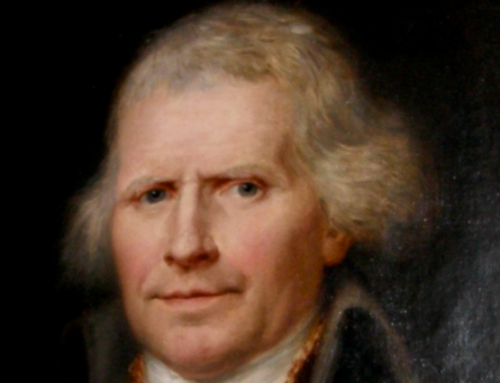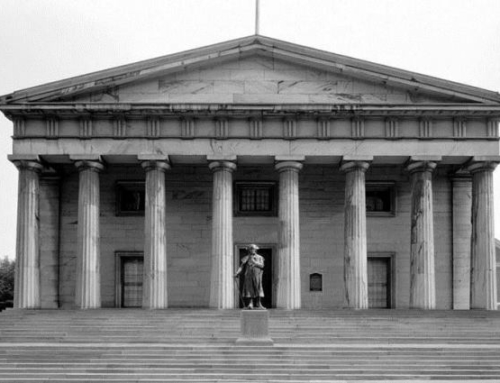By the same token, of course, to say that a “good” message makes for good art is both foolish and dangerous. Just as the “art” of Socialist Realism, with its paintings of stylized scenes of heroism in the name of “the workers,” is both nasty, lying propaganda and schlock, so the various renderings of “The Apotheosis of Washington” depicting our first President being taken to heaven to become a god, are both artistically and morally disordered. Washington was a truly great President, but art that turns politicians—or even true statesmen—into idols corrupts our sense of proportion regarding human goods, and risks undermining the call to virtue by making it seem ridiculous.
What, then, makes for great political art? Nothing. If it is just about politics, folks, it is not art. Even if the message is one we happen to like, political commentary is just that, political, and it should not be confused with art, which has higher aims. This is not to say, of course, that art never concerns the political—often it does. But the requirement to make art in this genre is an intelligence and concern with higher goods that is increasingly difficult to find. Statues showing the nobility of great figures, if well conceived and executed, can be great art—we are blessed with a fair amount of such public art, though relatively little of it has been produced since the death of Frederick Hart. Satire often is political, and if it aims to show both the foibles of a particular time and place and the lasting issues of, say, pride and vanity (I am thinking, here, of Jonathan Swift, but Aristophanes and many others examples could be used), then it, too is great art.
Among the many ironies spawned by our culture wars has been the claim that bad art deserves praise, and public funding, because it is political. Of course, that is not how it is phrased. The argument is that art, and “important” or “great” art in particular, transgresses boundaries; it shocks us into reconsidering our assumptions about social structures, thereby enlightening us. The “enlightening” is always done from a leftist perspective, however, and the questioning is always about “structures” like religion, the family, and economic liberty that form the core of our tradition. But that is just one of the conveniences of living in an era that mistakes “progress” for improvement to the human condition: you get to call anyone who defends tradition a reactionary who would re-impose slavery if he could, and call him an ignorant rube who knows nothing about art. So, to point out that placing a crucifix in a bottle of your own urine, then taking a photograph of it constitutes a base insult to people’s deeply held beliefs makes you a would-be tyrant, and to point out that contempt and a camera do not constitute great art is to make you a stupid fool.
Still, we face the problem that our public opinion makers identify art with leftist politics rather than the moral imagination. And this pervasive falsehood alienates good people from good art as it gives propagandists an aesthetic high ground their work does not merit. One way to debunk this myth is to simply point out what bad people many of the “great” men and women of leftwing “art” actually were (Paul Johnson’s Intellectuals does a great job, here). But I prefer to remember Charlton Heston’s response to an interview question about liberal movie stars. In essence, he asked why anyone would care what people who play-act for a living think about something as important as public policy. Of course, many people in the world of art are quite intelligent. But Heston clearly was correct that nothing in their specific, professional training prepares artists to do more than mimic the superficial utterances of watered-down ideology. And the desire to spout such ideology bespeaks a shallow concern to court fame, rather than an artist’s desire to create great art.
One of our real problems as a culture is that so many of us care what people motivated by the desire for fame tell us we should believe and do. We have entered into a vicious feedback cycle, in which our famous people parrot what they think the masses want to hear, and then the masses parrot it back again because, well, the people who are famous say it, so it must be true. Shallow cultural narcissism is the inevitable result, and those working with less popular forms of art—say, painting—are just as likely to succumb to this generalized cultural disorder as pop stars.
It was not always this way. Even defenders of “the shock of the new” know it was not; which is why they contrast today’s politicization with the “bad old days” of pre-modern art, in which the Church supposedly sought to prevent all innovation by looking for heresy in every scrap of art. That view is wrong, of course. Public art in the Middle Ages was generally religious because religion was central to public life at that time. And there were many arguments over what forms of art (plainchant or polyphony in choral music, for example) would best serve the needs of the liturgy—the result being the great art of Palestrina and Monteverdi. Moreover, anyone who knows anything about this highly varied era, with its troubadours, its travelling theater groups, and its heroic poetry, should know that staid, religiously “oppressive” art was not the norm. Does this mean art was “radical” in this era? Of course not. High art aimed at the transcendent, seeking to convey truths of eternal importance. Lower forms of art were just that, rooted in daily experience and enjoyed as such by many, even as it was looked down upon by many others.
For most of human history, highly varied, often controversial art shared a concern to capture and convey permanent truths, not simply to score political or intellectual points in some imaginary game. It often included sharp criticism of powerful people or institutions. But what made it art was, and was recognized to be, its instantiation of higher goods. Whether a liturgical chant, or the satire of “The Marriage of Figaro” (Mozart’s comic opera, based on Beaumarchais’s more politicized stage comedy) or the painful modernism of Eliot’s The Wasteland, art by nature seeks to capture the beauty, horror, and possibility for virtue that make up the moral imagination. Sometimes art broke “new ground” and sometimes it reflected troubling values. Stravinski’s “Rite of Spring,” as a ballet, is a powerful but rather disordered rendition of pagan death ritual. Voltaire’s Candide is cynical and superficial—a precursor, really, of modern propaganda. But the vast bulk of “old” art is culturally enriching because its makers, whatever their political views and whatever their views regarding artistic innovation, sought connection with the Permanent Things. Of course there were exceptions, and much bad art, as there always will be. But only after the late nineteenth century did our perception of art itself begin to change.
Impressionism and Cubism actually were early turns toward academicism in art, seeking a sense perception beyond the eye’s capacity, though often achieving great beauty nonetheless. The fatal break occurred with pop art and socialist realism—otherwise known as shallow propaganda. It was with these movements that art began to give way to shallow propaganda. Increasingly, the effort of developing technical skills, mastery of traditional forms, and the capacity to see and realize in physical space a vision of the eternal was seen as too much trouble for most artists. Goodness knows it is less difficult and time-consuming to be vulgar and insulting. So, if you can get people to believe that the entire point is to be vulgar and insulting (and to be given grant money to do so), well, life is good.
Our deeper problem as a culture is that so little high art is being produced, and what there is tends to be highly academic. The propaganda that passes as art is not the whole of art, even today. Most of our “high” art is simply irrelevant to anyone but academics. Color studies, sound experiments and the like are not highly damaging to the culture, they simply do not speak to most of us and fail to train artists for their higher calling of forming works of beauty, capturing deeper truths of the human condition, and stirring within us recognition and longing for virtue. Sadly, the academic experimentalism of most contemporary high art succeeds only in being vaguely ridiculous or simply ugly. Non-figurative abstraction, whether on the canvas or in the “structures” of 12 tone music is for the mind, not the ear or the eye—or the soul. And this has left the field open for the propagandists.
Academic art certainly has its place. Cubism and impressionism aim at perspective; they are not bad art, and can be great art. But they, and their successors in particular, are somewhat narrow, intellectual art, more concerned with the internal goals of the art community than with playing a role in public life. They aim at accuracy or other technical goals rather than depicting permanent goods like beauty and virtue. Unfortunately, then, they leave out a crucial human element, which has been filled by schlock. And this means that, as a people, our moral imagination is being left to starve.
We remain lucky in that we can call on centuries-long traditions in music, literature, and the visual arts. And, in the shadows, ignored by the media and the arts establishment, true art continues to be made. A treatment of such good art would be the stuff of its own post, or book, but for a start one might consider Arvo Part in music or, represented on this very site, Duncan Stroik in architecture. But “the mainstream” has become the left stream of, in essence, propaganda.
None of this is to say that we are without resources in the culture war. Taken as a whole, there is far more good art than bad art available to us. All we have to do is patronize the “old-fangled” artistic institutions (my kids have enjoyed museums all their lives—there always are things that are “neat” and “cool” in them, though sometimes that means a suit of armor or sarcophagus). As much as anything, though, it is important for each of us to refuse to bow down to the claims of the propagandists; they are not our cultural avant-garde, seeking to enlighten us. All too many of them are spoiled children who need to go back to school to learn how to draw.
Books on the topic of this essay be found in The Imaginative Conservative Bookstore.








"Still, we face the problem that our public opinion makers identify art with leftist politics rather than the moral imagination."
This sentence really does grasp the problem, although it also makes the presumption that leftist politics is morally unimaginative – which is not necessarily true. There is a great moral and patriotic drive in critical art, but it is easy to mistaken for merely some sort of juvenille nihilism on the part of artists (akin to the character of the protagonist of Orwell's Keep the Aspidistra Flying). Of course, this blindness to a moral and patriotic core exists amongst artists as well relative to the bourgiouse, who in their view are merely crass materialists rather than prime examples of peaceful enterprise and natural (family) community.
The misunderstandings between the political partisans of culture are often regrettable and totally unnecessary. I have had my share of battles with Catholics who (to give an example) regarded a theatre production as profane because it showed "Jesus with breasts", not realizing that it was a portrayal of St. Vilgefortis. Likewise, I have had my share of angry feminists (who happened to be men) frown upon my custom of kissing women on the hand – something taught to me by women, who wished me to adopt this Polish tradition. Ironic, since it seemed I was trapped between the rock of "cultural sensitivity" and the hard place of feminism. In the end, the problem is that illiberal habits threaten us whenever we filter the Other through the lense of ideology rather than a truly open and inquisitive mind.
Still, I wrote a rather long piece on this subject back in 2005, and I will let it speak for itself. While the context of the piece is foriegn to America, the observations are not:
http://thepolitics.pl/poland/cultivating-the-good-republic-10#.URH0n2RyfbU
Many thanks, Dr Frohnen. you might find a rare copy of Duncan Williams' "Trousered Apes" (UK, early 1970s) for another good dissection of Romantic Art and its ideological crack-up. Williams finds two ideological roots in Romanticism – an insistence on novelty and subjectivity -and he traces these to their modernist reductios. ideology, like a railway, comes to the 'end of the line.' i think that you would find it well worth the effort of finding a copy
Art is political. The Left has made it so. Marx identified four ways that a cultural can be manipulated. They are: Education, Law, Religion and the Arts. The left is working its way on the long slow march through the institutions and their goal is a political one. They are operating within the Arts every day to change or comment on our mores and values hence things like the "Piss Christ" you mention. But where is our volley back? Do we not engage because Beauty is not "political"? It is now. It has been politicized and marginalized, and called racist and sexist. If a sculptor was today to produce Michelangelo's Pieta and put it on display, in reaction to the Piss Christ he would be engaging in a political act simply by using traditional art and modes of beauty to refute the anti-Christian message. Or that same "modern" Mike Angelo could create the exact same work as the Renaissance sculptor, and title it "God is Dead, What a Pity" and we would see the intense beauty as a commentary on the death of religion and Christian belief rather than something that reifies belief. Meaning is created by the viewer, not the object.
Being a Christian today is a political act. Standing up for traditional notions of Beauty, Truth, and Goodness is a political act. Conservatives are being routed in the culture wars because we refuse to fight. We refuse to engage in the creation of "political" art, which reflects our values because "art is not political." I have a background in theater, I can tell you that theater and performance is inherently political and it is central to the fight we must make. We must find ways of Performing our values in visible ways that bring people to us. All art has a point of view. Even a painting of a bowl of fruit is engaging somehow with the artistic tradition. It either reifies the status quo and "traditional" values for its moment, or it challenges those somehow. (And frankly if it is doing exactly the same thing as the other art of its day, then it is not really art) We are surrounded by art that challenges our values. It is about time that we produced some that reifies them. I would also argue that I think the pendulum has swung so far to to the Leftist POV as the dominant mode of art now that our "traditional values" could be seen as a challenge to the current hegemonic Marxist culture, placing us in position to challenge those Marxist notions, in an effort to advocate for Beauty, Truth and Goodness.
The Museum you praise is also not free from politics. Every day the curators make decisions on how much space to give to various artists, and exhibitions. Like the editors of leftist newspapers and TV you are one head curator away from seeing many of your favorites go the way of the dodo, because they are the products of the Western Tradition and "The museum must show more diversity in our collections." That is a political act too.
We are engaged in a cultural war. The battlefield has been prepared for us by our enemies, as they lay waste to the Western Tradition. We must fight for it, or be content in the conservative rout.
Hard to believe that Prof. Frohnen teaches law. I never encountered anyone like him at CUNY. He hits several nails on the head here. Timely personally and culturally. We've certainly come to see the Middle Ages through the shriveled vision of Monty Python. It was the Venerable Archbishop Fulton J. Sheen who warned of the politicization of theology, and of everything. I worked in NY publishing for nearly a decade and it was unfortunately a personal battle I was never going to win. But it is a battle that can't be avoided as you write. In the battle of sound and vision we should be winning given the impoverished culture of the last century or so.